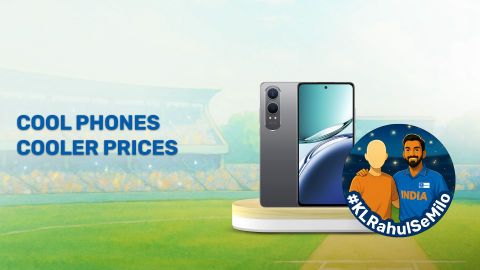The MediaTek Helio G88 and the Qualcomm Snapdragon 680 4G are both mid-range chipsets designed for everyday smartphones. Each comes with eight cores that can smoothly handle daily activities like browsing, social media, video streaming, and light gaming. The Helio G88 is built on a 12-nanometre process, while the Snapdragon 680 is based on a more efficient 6-nanometre design, giving it an advantage in power use and heat control.
In performance, the Snapdragon 680 generally leads in single-core tasks such as app launches and scrolling, thanks to its higher clock speeds. For graphics, the Helio G88 uses a Mali-G52 MP2 GPU, while the Snapdragon 680 relies on the Adreno 610. Both manage casual gaming well, but the Snapdragon 680 performs better in graphics-heavy titles and offers smoother visuals.
When it comes to multitasking and display support, the Snapdragon 680 has an edge with stronger memory bandwidth and support for higher refresh rates. The Helio G88 still handles day-to-day multitasking reliably, but it is not as capable when pushed to demanding levels. This makes Snapdragon 680 better suited for users who need consistent performance across apps. For users who prioritise performance, Snapdragon processor phones often offer a smoother experience, especially in tasks requiring high CPU and GPU performance.
Battery efficiency differs between the two. The Helio G88 can be power-hungry during heavy use because of its 12-nanometre process, while the Snapdragon 680 offers better efficiency under both light and demanding workloads due to its modern 6-nanometre build. This gives Snapdragon 680 the upper hand in longer battery life and better overall balance. If you are looking for an affordable yet efficient smartphone, exploring MediaTek processor phones could be a great option. choice in the mid-range segment.
Technical specifications - MediaTek Helio G88 vs Qualcomm Snapdragon 680 4G
The MediaTek Helio G88 and Qualcomm Snapdragon 680 are mid-range chipsets designed to balance performance and efficiency. The Helio G88, built on a 12nm process, focuses on affordability, while the Snapdragon 680, with its advanced 6nm process, offers improved power efficiency and higher clock speeds. Both support Full HD+ displays, 64MP cameras, and strong connectivity features, making them reliable choices for budget-friendly smartphones.
General info
The MediaTek Helio G88 and Qualcomm Snapdragon 680 are processors made for budget and mid-range phones. The Helio G88 was designed to bring good performance at an affordable cost, while the Snapdragon 680 focuses more on battery efficiency and smooth usage. Both options aim to deliver balanced features for everyday smartphone tasks such as calling, browsing, and using apps.
Specification
|
MediaTek Helio G88
|
Qualcomm Snapdragon 680 4G
|
Announced
|
15 July 2021
|
26 October 2021
|
Class
|
Mid-range SoC
|
Mid-range SoC
|
Model number
|
MT6769H
|
SM6225
|
Brand
|
MediaTek
|
Qualcomm
|
CPU
The MediaTek Helio G88 comes with a mix of powerful and efficient cores to handle daily tasks with ease. The Qualcomm Snapdragon 680 uses a slightly different set of cores and works on a smaller process, which makes it more power-saving. This helps the Snapdragon 680 phones last longer on a single charge, while still offering stable performance for apps.
Specification
|
MediaTek Helio G88
|
Qualcomm Snapdragon 680 4G
|
Architecture
|
ARM Cortex-A75/A55
|
ARM Cortex-A73/A53
|
Cores
|
8 cores (2x A75, 6x A55)
|
8 cores (4x A73, 4x A53)
|
Frequency
|
Up to 2.0 GHz
|
Up to 2.4 GHz
|
Instruction set
|
ARMv8-A
|
ARMv8-A
|
Process
|
12nm
|
6nm
|
TDP
|
5–6 W
|
5 W
|
Manufacturing
|
TSMC
|
TSMC
|
Graphics
The MediaTek Helio G88 uses Mali graphics while the Snapdragon 680 uses Adreno graphics. Both allow smooth video playback and decent gaming, but Snapdragon’s Adreno graphics are better at handling visuals with more detail and stability. For a casual gamer or someone who watches movies on their phone, both processors will deliver good results without much lag.
Specification
|
MediaTek Helio G88
|
Qualcomm Snapdragon 680 4G
|
GPU name
|
ARM Mali-G52 MC2
|
Adreno 610
|
Architecture
|
Bifrost
|
Adreno 600
|
GPU frequency
|
1000 MHz
|
950 MHz
|
Execution units
|
2
|
1
|
Shading units
|
32
|
128
|
Total shaders
|
32
|
128
|
FLOPS
|
96 GFLOPS
|
180 GFLOPS
|
Vulkan version
|
1.1
|
1.1
|
OpenCL version
|
2.0
|
2.0
|
DirectX version
|
12
|
12
|
Memory
The MediaTek Helio G88 and Snapdragon 680 both support fast mobile memory, allowing apps to open smoothly and multitasking to feel seamless. The Snapdragon 680 has slightly higher support, which means switching between apps feels quicker. For most users, both processors ensure daily tasks like chatting, streaming, and browsing work without delay, making them reliable choices for mid-range devices.
Specification
|
MediaTek Helio G88
|
Qualcomm Snapdragon 680 4G
|
Memory type
|
LPDDR4X
|
LPDDR4X
|
Memory frequency
|
1800 MHz
|
2133 MHz
|
Bus
|
2x16-bit
|
2x16-bit
|
Max bandwidth
|
14.9 GB/s
|
17 GB/s
|
Max size
|
8GB
|
8GB
|
Multimedia (ISP)
The MediaTek Helio G88 and Snapdragon 680 allow smartphones to handle cameras and displays effectively. Both support full HD displays and cameras up to 64MP, making them capable of clear photos and smooth video recording. While both manage video playback well, Snapdragon adds better support for wireless audio, which can enhance the sound experience when using Bluetooth earphones.
Specification
|
MediaTek Helio G88
|
Qualcomm Snapdragon 680 4G
|
Storage type
|
UFS 2.1, eMMC 5.1
|
UFS 2.1, eMMC 5.1
|
Max display resolution
|
2520 x 1080 pixel
|
2520 x 1080 pixel
|
Max camera resolution
|
64MP
|
64MP
|
Video capture
|
1080p at 60 FPS
|
1080p at 60 FPS
|
Video playback
|
1080p at 60 FPS
|
1080p at 60 FPS
|
Video codecs
|
H.264, H.265
|
H.264, H.265
|
Audio codecs
|
AAC, MP3, FLAC, LDAC
|
AAC, MP3, FLAC, aptX
|
Connectivity and network
The MediaTek Helio G88 and Snapdragon 680 both provide reliable 4G support with steady internet speeds for browsing and streaming. Neither has 5G support, but they cover all the basics like Wi-Fi, Bluetooth, and GPS. The Snapdragon 680 has a newer Bluetooth version, which offers better wireless connectivity and improved performance for headphones and speakers compared to the Helio G88.
Specification
|
MediaTek Helio G88
|
Qualcomm Snapdragon 680 4G
|
Modem
|
LTE
|
LTE
|
4G support
|
Yes
|
Yes
|
5G support
|
No
|
No
|
Download speed
|
390 Mbps
|
390 Mbps
|
Upload speed
|
150 Mbps
|
150 Mbps
|
Wi-Fi
|
Wi-Fi 5 (802.11ac)
|
Wi-Fi 5 (802.11ac)
|
Bluetooth
|
5.0
|
5.1
|
Navigation
|
GPS, GLONASS, BeiDou, Galileo
|
GPS, GLONASS, BeiDou, Galileo
|
MediaTek Helio G88 vs Qualcomm Snapdragon 680 4G - Benchmarks
The MediaTek Helio G88 vs Qualcomm Snapdragon 680 4G benchmarks show clear differences in real-use speed and graphics. The Snapdragon 680 scores higher in CPU, GPU, memory and UX tests, meaning it handles multitasking and gaming more smoothly. The Helio G88 still performs well for everyday apps and media, but Snapdragon delivers faster responses and better visual performance under heavier loads.
AnTuTu 10
The MediaTek Helio G88 and Snapdragon 680 perform differently in benchmark tests. The Snapdragon 680 shows stronger scores, meaning it feels faster in daily use and gaming. For most people, this translates to smoother app performance and less waiting time. The Helio G88 still provides steady results, but Snapdragon leads when it comes to handling heavy usage.
Component
|
MediaTek Helio G88
|
Qualcomm Snapdragon 680 4G
|
CPU
|
77,000
|
102,000
|
GPU
|
30,000
|
49,000
|
Memory
|
34,000
|
38,000
|
UX
|
45,000
|
60,000
|
Total score
|
186,000
|
249,000
|
GeekBench 6
The MediaTek Helio G88 and Snapdragon 680 both handle regular smartphone tasks well, but Snapdragon performs better in areas like browsing and image processing. This means phones with Snapdragon 680 can manage apps, photos, and productivity tools more smoothly. The Helio G88 still works fine for basic use, but Snapdragon is more dependable for faster everyday performance.
Component
|
MediaTek Helio G88
|
Qualcomm Snapdragon 680 4G
|
Asset compression
|
500
|
700
|
HTML 5 browse
|
1,100
|
1,300
|
PDF render
|
900
|
1,100
|
Image detection
|
850
|
1,150
|
HDR
|
300
|
450
|
Background blur
|
700
|
950
|
Photo processing
|
400
|
700
|
Ray tracing
|
No
|
No
|
3DMark
The MediaTek Helio G88 and Snapdragon 680 both deliver steady performance in graphics testing, but Snapdragon handles visuals better, especially for gaming and detailed rendering. This means games and graphic-heavy apps run smoother on Snapdragon devices. Helio G88 still gives a stable experience but is not as strong for users who want higher quality graphics and faster response during play.
Component
|
MediaTek Helio G88
|
Qualcomm Snapdragon 680 4G
|
Stability
|
99%
|
98%
|
Graphics test
|
800
|
1,200
|
Score
|
1,400
|
1,900
|
MediaTek Helio G88 vs Qualcomm Snapdragon 680 4G phones – Price list in India
The MediaTek Helio G88 and the Qualcomm Snapdragon 680 4G are widely used in budget and mid-range smartphones. The Helio G88 is mostly found in affordable models, while the Snapdragon 680 often appears in slightly higher-priced phones with better efficiency. This makes the Snapdragon option more costly, but it provides smoother usage and longer battery life. Both remain popular choices in India.
Processor
|
Typical smartphone price in India
|
MediaTek Helio G88
|
Rs. 9,000 – Rs. 12,000
|
Qualcomm Snapdragon 680 4G
|
Rs. 12,000 – Rs. 16,000
|
Disclaimer: Prices may vary over time, kindly refer to the official website for the most accurate and updated pricing.
Shop for latest smartphones, laptops, or other gadgets on Easy EMIs from Bajaj Finserv and repay across a convenient tenure ranging between 3 months to 60 months. You can buy your favourite products on huge discounts on Bajaj Finserv. Explore the latest offers to get the best deal today.
Turn good deals into great ones. Use our Maha Bachat Calculator to combine multiple offers and unlock your best possible deal. Calculate your extra savings now.
Shop smart with Easy EMIs
Bajaj Finserv puts you in control of your shopping. See if you are eligible for a loan and get instant approval in just a few steps. Once approved, go to any of 1.5 lakh+ partner stores across India. Pick from over 1 million products from 550+ leading brands. Pay in Easy EMIs with 50+ flexible options that fit your budget. Enjoy a fast, seamless, and stress-free shopping experience—with more freedom and more savings.
Why use the Maha Bachat Savings Calculator
Bajaj Finserv’s Maha Bachat Savings Calculator helps you unlock maximum savings every time you shop at partner stores. It brings together all available brand, dealer, and scheme offers—so you can see your total savings instantly and shop smarter with Easy EMIs.
Dealer offers - Grab exclusive in-store deals at over 1.5 lakh partner stores across India. Enjoy local discounts and special prices you will not find online.
Brand offers - Access limited-time discounts from top brands across electronics, appliances, and more. Discover brand-specific savings selected just for you.
Bajaj offers - Unlock exclusive Bajaj Finserv deals on popular products—available only to our customers. More rewards, more value.
Scheme offers - Take advantage of time-sensitive offers on select EMI schemes. Get extra benefits after paying just 3 EMIs—visible during EMI selection at checkout.
Upcoming mobiles by brand
Mobile by budget
5G mobiles by brand
5G mobiles by budget
Brand by budget (Rs. 20,000)
vivo mobile under Rs. 20,000
|
Samsung mobile under Rs. 20,000
|
OnePlus mobile under Rs. 20,000
|
iQOO mobile under Rs. 20,000
|
Xiaomi mobile under Rs. 20,000
|
POCO mobile under Rs. 20,000
|
Infinix mobile under Rs. 20,000
|
realme mobile under Rs. 20,000
|
motorola mobile under Rs. 20,000
|
HUAWEI phones under Rs. 20,000
|
|
|

















